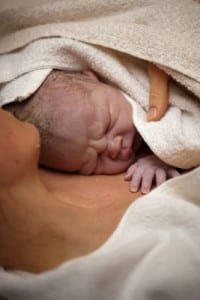
One theory, from Statistics Canada, is that there are just more moms. The census numbers show that there are more women ages 20 to 34 – average child rearing ages and a modestly higher fertility rate in most regions.
“This is the main reason for the increase,” said David Foot, an economics professor at the University of Toronto and co-author of the 1996 bestseller, “Boom, Bust and Echo,” a book that explored how demographics can explain economic trends. He says that the “echo” portion is that children of the baby boomers are now having children of their own. “These echo boomers, now in their early 30s, are starting their own families. These are the boomers’ grandchildren being born.”
Roderic Beaujot, a demographer at Western University’s Center of Population, Aging and Health in London, Ontario, says that demographics do play a part in the increase of Canadian children the last five years, but that there are other factors as well.
Much like women in other parts of the world, women in Canada have put off having children to give themselves time to pursue careers, establish personal relationships, continue education and develop more financial stability. Now that they feel they are ready, they have started having children.
“In some sense, the delay is coming to an end,” said Beaujot. “Because you can’t delay much more.”
He also suspects that more women are choosing to have children today than in the previous years. Women who joined the workforce in previous years may not have felt confident enough about being able to work and have families. Several changes in government policy may have given them back some of that security.
For example, Quebec has a $7-a-day daycare program. Additionally, the federal government gives every Canadian family $100 for every Canadian child under the age of six as a part of its Universal Child Care Benefit. This money doesn’t have to be used for daycare, specifically, however. Karen Hach, mother of four young boys in Edmonton, sets the money aside to help fund college tuitions in the future. She says that she and her husband started planning for college for their children as soon as they were born. With the cost of tuition these days, it’s not hard to understand why.
“I just take the money I get from Stephen Harper every month and pop it into their RESPs,” said Karen.
Even though her husband works a well-paid job in the oil field, Karen says that they watch their spending closely, and with only their oldest son in school right now, the cost of daycare for three children would simply be too much to bear. So, for now, Karen stays home with the three younger boys.
And Karen isn’t alone. While many moms may decide to withdraw from the workforce for a while to raise their children, many of them are returning eventually. This fact only further strengthens Canada’s already thriving workforce. Part of this is attributed to the fact that women can leave their jobs for a period of time after child birth and return, without fear of recourse from their employers.
“Young people feel confidence in the labor market,” said Beaujot. “They can even withdraw from the labor market for a while, knowing that they can get a job when they go back in…It gives them confidence so they can have children, and it’s not particularly risky from an economic point of view.”
And even while out of the workforce, some Canadian mothers are finding inventive ways to make a living. Erin Koestlmaier, a mother of three in Edmonton, runs her own business called Fit Mommy. She teaches other moms how to “strollersize” – exercise while working out and pushing a stroller. She also does boot-camp workouts for women who want to lose their baby weight or stay in shape. The demand has been so great that she’s considering adding another class. She’s also considering adding another baby. Her husband Mike, however, is not quite so certain.
“He’s not necessarily on board, but I’d like to go for a fourth,” Erin stated.
I can’t help but feel jealous sometimes that Canadian moms receive such support, freedom and security in the difficult balance of motherhood and employment from their federal government. Americans receive very little support or security after starting families. What support is offered is generally geared towards low-income families.
In some states, like Arizona, the childcare system is not even available to those that need it. The waiting list is so long that you won’t see childcare benefits until your child is well into school. That, of course, prevents the mother from returning to work. It’s a pretty sad situation we live on when what few benefits we do have can’t even cover those that need it most.
Americans complain constantly about having to pay taxes to support things like childcare, health insurance, maternity leaves and more. Yet it would seem that Canada has figured out a way to make a system like that work. No, I regress. It doesn’t just work; it seems to be thriving. It would seem to me that the United States could learn a lot about strengthening the workforce from its northern neighbors.
Related Articles:
- CDC Links Higher Education Levels and Higher Income to Healthier Lifestyles
- Why is Maternity Leave in the U.S. Severely Lacking?
- United States Ranked 25th of Developed Countries for Raising Children






